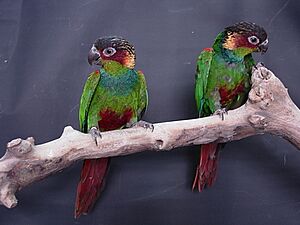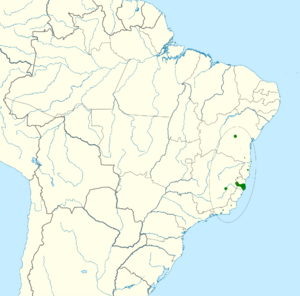Ochre-marked parakeet facts for kids
Quick facts for kids Ochre-marked parakeet |
|
|---|---|
 |
|
| Conservation status | |
| Scientific classification | |
| Genus: |
Pyrrhura
|
| Species: |
cruentata
|
 |
|
The ochre-marked parakeet (Pyrrhura cruentata) is a type of parrot that lives in Brazil. People also call it the blue-throated parakeet or red-eared conure in English. In Portuguese, it has names like tiriba-grande and cara-suja. This bird is listed as Vulnerable (VU) on the IUCN Red List, which means it needs protection.
Contents
About the Ochre-Marked Parakeet
This colorful parakeet is mostly green. It has bright red patches on its tummy, bottom, and shoulders. You can also see red around its eyes. Its head is dark brown or black, fading into a spotted pattern on the back of its neck. It has a wide, bright blue patch on its chest, which looks like a bib. This blue color also goes around the back of its neck, forming a light collar. Its outer wing feathers are blue. Its tail is olive-green on top and brownish-red underneath.
Where They Live and What They Eat
This parakeet lives high up in the trees of warm, wet forests. It can sometimes be found in areas up to 960 meters high. It also lives near the edges of forests or in places where some trees have been cut down. Sometimes, it even lives in farm areas where many forest trees are still standing, like in cocoa plantations that use shade trees.
The ochre-marked parakeet eats seeds and fruits from trees that grow in new forest areas. These include trees like Trema micrantha and Cecropia. Scientists have not seen them eating farm crops in the wild. These birds usually lay 2 to 4 eggs in a tree hole during the spring in the southern part of the world.
Where to Find Them
The ochre-marked parakeet used to be common in many parts of south-east Bahia, Espírito Santo, east Minas Gerais, and Rio de Janeiro, Brazil. Now, they are found in much smaller, separate areas. Most of them live in protected places like the Sooretama Biological Reserve and the nearby Linhares Forest Reserve in Espírito Santo. They are still common in Estação Vera Cruz (which used to be the Porto Seguro Reserve) in Bahia. In other large national parks like Chapada da Diamantina and Monte Pascoal in Bahia, their numbers seem to be low.
How Many Parakeets Are Left?
Experts estimate that there are between 2,500 and 9,999 ochre-marked parakeets in total. This number helps us understand how many of these special birds are still living in the wild.
Dangers They Face
The biggest problem for these parakeets is that their forest homes are being cut down. This is called deforestation. Because of this, their living areas are now broken up into small pieces. Even though they can live in cocoa plantations that use shade trees, new farming methods use different trees like banana and Erythryna, which don't help the parakeets. Also, when cocoa prices change, farmers sometimes turn these plantations into pastures, which means more forest is lost.
Some groups of parakeets face other dangers. For example, in Monte Pascoal National Park, there are sometimes disagreements between protecting the birds' habitat conservation and the needs of local people. Another problem is that people sometimes trap these birds to sell them as pets. While this is a newer threat, it still affects their numbers.
Protecting the Parakeet
Many efforts are being made to protect the ochre-marked parakeet. It is listed on CITES Appendix I, which means it is highly protected from international trade. Brazilian law also protects this bird.
The parakeet lives in several important protected areas. These include:
- Chapada Diamantina National Park
- Monte Pascoal National Park
- Barrolândia Experimental Station
- Linhares Forest Reserve
- Caratinga Biological Station
- Rio Doce State Park
- Probably Desengano State Park
- Córrego Grande Biological Reserve
- Córrego do Veado Biological Reserve
- Sooretama Biological Reserve
These protected areas are very important for the survival of the ochre-marked parakeet.


